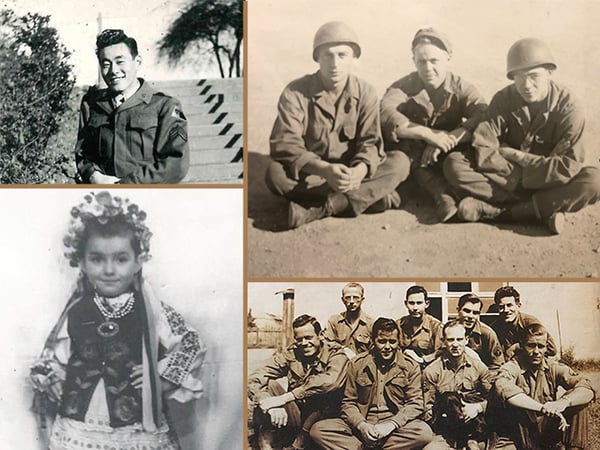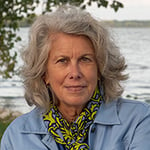Published: May 22, 2021
 Kendal at Oberlin residents share many values, including creativity, resiliency, love of learning and concern for others. So, when the pandemic hit, residents came up with many ways to combine all of them.
Kendal at Oberlin residents share many values, including creativity, resiliency, love of learning and concern for others. So, when the pandemic hit, residents came up with many ways to combine all of them.
One of these efforts is a 30-minute video featuring four residents who shared stories about their lives during World War II. “Kendal Stories of WWII” had its virtual “world premiere” this month at Kendal and is now available for the public to view on Kendal’s YouTube channel.
Resident Mary Behm recorded the interviews on her husband’s IPhone 8 and moderated the premiere showing. “I felt honored to hear your stories,” she told the interviewees.
Oberlin College also participated in the project. Geoff Pingree, co-director of Oberlin College’s Cinema Studies program and director of StoryLens, provided technical assistance, and OC graduate and StoryLens fellow Clarissa Heart, did the editing. They both attended the premiere.
“You all are really interesting people and have different relationships to the war,” Geoff said.
Meet the Kendal Residents who Shared their Stories:
John Akira Matsushima, Japanese American interned during the war
John was a teenager living in Seattle when Pearl Harbor was attacked by the Japanese. The next day at school he and other Asian American students were shunned by their white friends and ignored by teachers. “Pearl Harbor, that changed everything,” he said.
John’s family and other Japanese American families were told to pack up and leave for internment camps. They left their house with a suitcase and walked down the middle of the street with armed soldiers lined up on either side, boarded a Greyhound bus that was guarded and went to live in camps with around-the-clock security.
“I’m an American, yet here I am the enemy. We were told it was for our own protection. There’s something wrong with that. Why would you jail the victims?” he said. “We lost everything during the evacuation.”
“If I get drafted, I will go,” he told others, and he did.
Jim K. Sunshine, an Army medic in a Field Hospital
Field Hospital medics took care of soldiers with abdominal and leg injuries. “This was the salvation of many people – 85 percent of them lived,” said Jim, who wore his dog tags for the video.
Jim was ordered to sit with a young German soldier who was dying. “I sat there all night while he moaned, I gave him water, that’s all I could do for him. At the end of the night he died. So, I got up and went back to surgery,” he said.
Jim said he no trouble coming back to America and resuming his life. “I just picked up at Oberlin where I had left off,” he said. He graduated from Oberlin College (1949), got married and had children. “In some ways the war made us a better people,” he said.
Bill Rice, served in the Army’s 100th Infantry Division
Bill remembers one serious battle. “I lost a lot of good friends. That was the worst day of my life, maybe the second worst. The fella in front of me was killed, and I raised my head up and I had a bullet go through my helmet – I came ¼, ½ inch away of having my head blown off.”
He was wounded in another battle and sent to a hospital in France. By the time he was well enough to return the war had ended.
“I made some really good friends,” he said, and several visited him and his wife years later.
Mary Van Nortwick, Ukraine native sent to Displaced Persons (DP) camps with her family
Mary was only 6-months old when her family left Ukraine for Displaced Persons camps, where she lived for six years.
One of her most valued heirlooms is an embroidery of the Madonna her mother sewed on a sugar sack. “My mother told me, ‘I’m making a prayer that somehow Mary will help us find a home.’ It has followed me everywhere since my mother gave it to me,” she said.
Mary’s family emigrated to Canada and they became citizens. “It’s kind of miraculous that we survived and thrived. “
Beyond the WWII video
“I grew up in Hawaii. I had no idea of refugee camps. It was fascinating to hear about those experiences,” Clarissa said during the premiere.
Oberlin College was one of a handful of colleges that admitted Japanese American students during World War II, which Geoff said is another reminder of the college’s contributions to American history. (Oberlin was also one of the first colleges to admit female and black students.)
Kendal is in the process of creating podcasts featuring the full interviews with each participant, and the Oberlin Heritage Center is considering using the material for a project.
Other residents have expressed an interest in recording their stories and Mary is looking for volunteers to take on the project. Mary is now president of the Kendal at Oberlin Residents Association (KORA) and her schedule is full, but added, “This was a very moving experience for me.”
Learn More About Kendal at Oberlin – A Vibrant Community for Older Adults
Are you making plans for your future? Kendal at Oberlin offers an active lifestyle with opportunities for lifelong learning, art and culture.
 In the past, Molly Kavanaugh frequently wrote about Kendal at Oberlin for the Cleveland Plain Dealer, where she was a reporter for 16 years. Now we are happy to have her writing for the Kendal at Oberlin Community.
In the past, Molly Kavanaugh frequently wrote about Kendal at Oberlin for the Cleveland Plain Dealer, where she was a reporter for 16 years. Now we are happy to have her writing for the Kendal at Oberlin Community.
About Kendal at Oberlin: Kendal is a nonprofit life plan community serving older adults in northeast Ohio. Located about one mile from Oberlin College and Conservatory, and about a 40 minute drive from downtown Cleveland, Kendal offers a vibrant resident-led lifestyle with access to music, art and lifelong learning.




